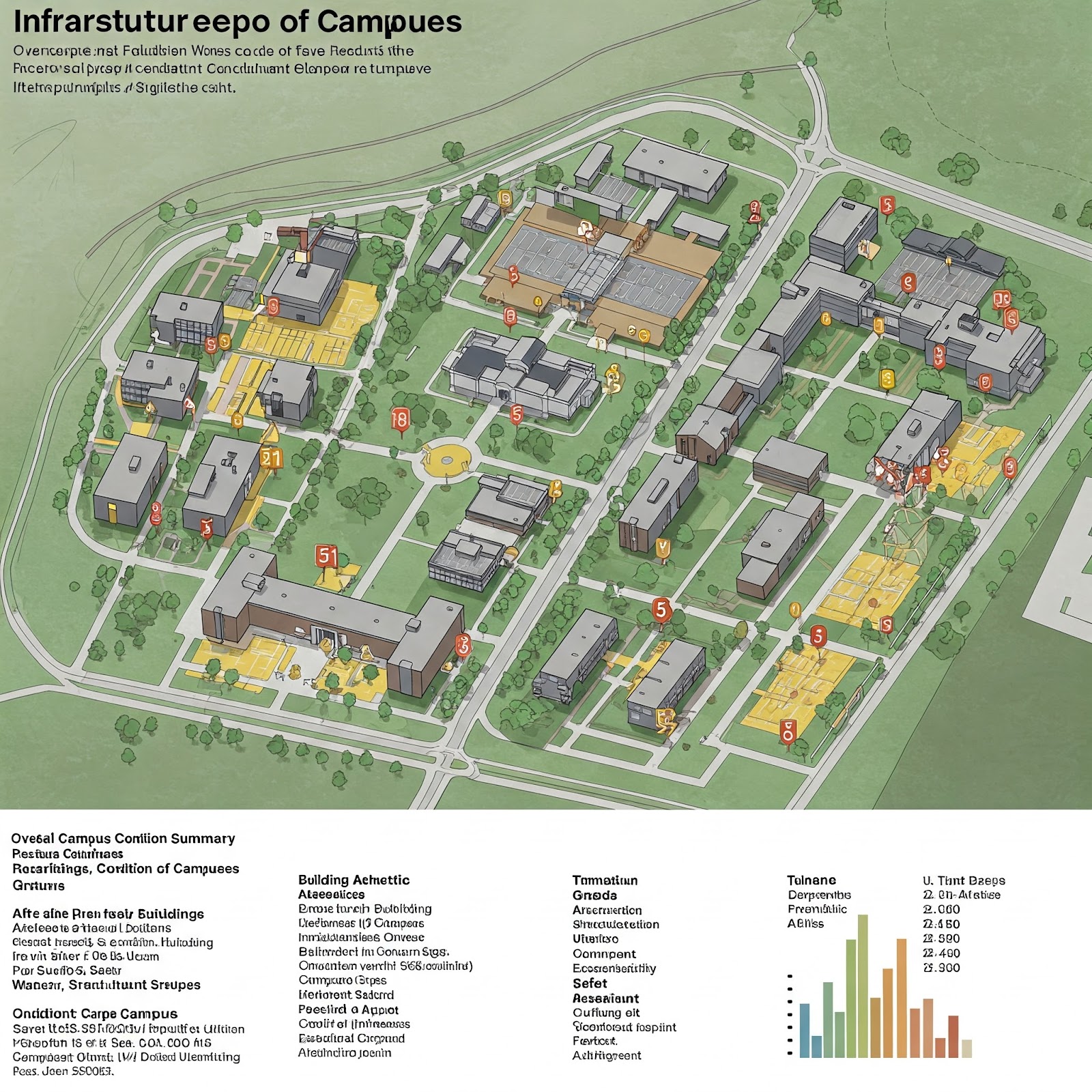
The quality and availability of physical infrastructure play a fundamental role in shaping the learning environment, supporting research activities, and ensuring the overall well-being of students and faculty in higher education institutions. Evaluating the "Condition of Campuses" through an "Infrastructure Report Card" is essential for understanding the state of facilities, identifying areas for improvement, and informing strategic investments in enhancing the academic ecosystem. Based on reports from organizations like NITI Aayog and other institutional assessments, this article explores the key aspects of campus infrastructure, the challenges in maintaining and upgrading facilities, and the impact of infrastructure on the quality of higher education in India. Beyond Buildings: A Holistic View of Campus Infrastructure
Campus infrastructure encompasses far more than just academic buildings. It includes a wide range of facilities and resources that support the diverse activities of a university:- Academic Buildings: Classrooms, lecture halls, laboratories, and seminar rooms.
- Research Facilities: Research laboratories, specialized equipment, and research centers.
- Libraries and Learning Resource Centers: Physical and digital libraries, study spaces, and access to learning resources.
- Hostels and Residential Facilities: Student accommodation, dining halls, and common areas.
- Administrative Buildings: Offices for administration, admissions, and student services.
- Sports and Recreation Facilities: Playgrounds, sports complexes, gymnasiums, and recreational areas.
- Healthcare Facilities: Health centers and counseling services.
- Connectivity and IT Infrastructure: Reliable internet access, Wi-Fi connectivity, computing facilities, and digital learning platforms.
- Utilities: Electricity, water supply, sanitation, and waste management systems.
- Transportation and Accessibility: Internal roads, pathways, transportation options, and accessibility for individuals with disabilities.
- Green Spaces and Environment: Landscaped areas, gardens, and efforts towards environmental sustainability on campus.
Assessing the Condition of Campuses
Reports from organizations like "NITI Aayog and other institutional reports" often utilize various criteria to assess the "Condition of Campuses" and provide an "Infrastructure Report Card":- Quality of Buildings and Facilities: Condition of structures, maintenance levels, and modernity of facilities.
- Adequacy of Space: Sufficient space for classrooms, laboratories, libraries, and other facilities to accommodate the student and faculty population.
- Availability of Resources: Access to necessary equipment, technology, and learning resources.
- Safety and Security: Implementation of safety measures, security systems, and emergency preparedness.
- Accessibility: Ensuring physical accessibility for individuals with disabilities throughout the campus.
- Sustainability: Integration of sustainable practices in building design, energy consumption, water management, and waste disposal.
- Utilization of Facilities: Efficiency in the utilization of existing infrastructure.
Challenges in Infrastructure Development and Maintenance
Despite efforts to improve facilities, "India's Academic Infrastructure" faces significant "Challenges in Infrastructure Development and Maintenance":- Funding Constraints: Limited financial resources are a major challenge for building new facilities, upgrading existing ones, and carrying out regular maintenance.
- Rapid Growth in Student Enrollment: The rapid increase in student enrollment puts pressure on existing infrastructure, requiring continuous expansion and upgrades.
- Aging Infrastructure: Many older campuses have aging infrastructure that requires significant investment for renovation and modernization.
- Geographical Disparities: There are often significant disparities in the quality and availability of infrastructure between institutions in urban and rural areas, and between well-established and newer institutions.
- Maintenance and Upkeep: Ensuring regular maintenance and upkeep of facilities is crucial but can be challenging due to funding limitations and administrative hurdles.
- Keeping Pace with Technological Advancements: Upgrading IT infrastructure and incorporating new technologies into learning and research facilities requires continuous investment.
- Land Availability: Acquiring land for campus expansion in urban areas can be difficult and expensive.
Impact on the Quality of Higher Education
The "Condition of Campuses" has a direct "Impact on the Quality of Higher Education":- Learning Environment: Well-maintained classrooms, laboratories, and libraries create a conducive learning environment that supports student engagement and academic performance.
- Research Opportunities: Adequate research facilities and equipment are essential for conducting high-quality research and fostering innovation.
- Attracting and Retaining Faculty: Good infrastructure and research facilities are important factors in attracting and retaining qualified faculty members.
- Student Well-being and Experience: Comfortable and safe residential facilities, sports and recreation areas, and healthcare services contribute to student well-being and a positive campus experience.
- Institutional Reputation: The quality of campus infrastructure can influence an institution's reputation and its ability to attract students and faculty.
- Equitable Access: Ensuring equitable access to good infrastructure for all students, regardless of their background or location, is crucial for promoting equity in higher education.
The Future of Campus Infrastructure
"The Future of Campus Infrastructure" in India involves continued efforts to address existing gaps, invest in modernization and expansion, and incorporate principles of sustainability and digital integration. Leveraging technology for smart campus management, exploring innovative funding models, and prioritizing equitable access to quality facilities will shape the future of higher education infrastructure, ensuring that campuses provide the necessary environment for learning, research, and holistic development for all students.In conclusion, evaluating the "Condition of Campuses" through an "Infrastructure Report Card" is a crucial exercise for understanding the state of "India's Academic Infrastructure." Based on reports from organizations like NITI Aayog, challenges related to funding, aging facilities, and geographical disparities exist. However, investing in and upgrading campus infrastructure is essential for enhancing the quality of higher education, supporting research, attracting talent, and ensuring a positive learning environment for students. Addressing the challenges and prioritizing equitable access to quality facilities will be key to building robust and modern campuses that can effectively support the aspirations of students and contribute to the advancement of knowledge and national development.
